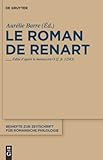Le roman de Renart : Edité d'après le manuscrit 0 (f. fr. 12583) / Aurélie Barre.
Material type: TextSeries: Beihefte zur Zeitschrift für romanische Philologie ; 356Publisher: Berlin ; Boston : De Gruyter, [2010]Copyright date: ©2011Description: 1 online resource (759 p.)Content type:
TextSeries: Beihefte zur Zeitschrift für romanische Philologie ; 356Publisher: Berlin ; Boston : De Gruyter, [2010]Copyright date: ©2011Description: 1 online resource (759 p.)Content type: - 9783110233421
- 9783110233438
- 841/.1
- PQ1507
- online - DeGruyter
- Issued also in print.
| Item type | Current library | Call number | URL | Status | Notes | Barcode | |
|---|---|---|---|---|---|---|---|
 eBook
eBook
|
Biblioteca "Angelicum" Pont. Univ. S.Tommaso d'Aquino Nuvola online | online - DeGruyter (Browse shelf(Opens below)) | Online access | Not for loan (Accesso limitato) | Accesso per gli utenti autorizzati / Access for authorized users | (dgr)9783110233438 |
Dissertation.
Frontmatter -- Table des matières -- 1. La matérialité du texte -- 2. Variantes et remaniements : l’oeuvre infinie -- 3. Principes d’édition -- 4. La langue du scribe -- Branche Ia : «Le Jugement de Renart» -- Branche Ib : «Le Siège de Maupertuis» -- Branche Ic : «Renart teinturier ; Renart jongleur» -- Branche II : «Le Duel judiciaire» -- Branche IIIa : «Renart et Chantecler» -- Branche IIIb : «Renart et la mésange» -- Branche IIIc : «Renart et Tibert» -- Branche IIId : «Tibert et l’andouille» -- Branche IIIe : «Tibert et les deux prêtres» -- Branche IVa : «Renart et Tiécelin» -- Branche IVb : «Le Viol d’Hersent» -- Branche V : «Renart et les anguilles» -- Branche VI : «Le Puits» -- Branche VIIa : «Le Jambon enlevé» -- Branche VIIb : «Renart et le grillon» -- Branche VIIc : «L’Escondit» -- Branche VIId : «La Confession de Renart» -- Branche VIII : «Renart et Liétart» -- Branche IX : «Les Vêpres de Tibert» -- Notes et commentaires -- Backmatter
restricted access online access with authorization star
http://purl.org/coar/access_right/c_16ec
Le manuscrit O du Roman de Renart est un manuscrit complet et tardif du début du XIVe siècle, omis de la collection de variantes d'Ernest Martin en 1887. Ce texte composite emprunte ses leçons aux différentes familles de manuscrits telles qu'elles ont été analysées par Hermann Büttner à la fin du XIXe siècle. L'édition proposée analyse la filiation des textes à travers une mise en perspective des principaux manuscrits du Roman de Renart: l'établissement du texte est en effet augmenté d'une varia lectio très détaillée. Cette analyse est aussi l'occasion de mettre au jour la mouvance du texte renardien et les procédés d'interpolation et d'en proposer une interprétation tant historique que littéraire. L'ouvrage s'accompagne en outre d'une introduction linguistique, de notes et de commentaires, d'un lexique, d'un glossaire, d'une table des noms propres et d'une bibliographie sélective.
This book provides a critical edition of the 'O' manuscript (beginning of the 14th century) of the Roman de Renart. It is supplemented by a varia lectio which takes into account the different readings of the most important 'branches' or short texts of the Roman de Renart. The edition includes an introduction of the work from the perspective of literary studies and philology and explores in detail the main linguistic characteristics of the manuscript. Furthermore, the introduction emphasizes the adaptability within the Renart tradition and documents the creativity of a scribe who added some verses of his own to the text he copied.
Issued also in print.
Mode of access: Internet via World Wide Web.
In French.
Description based on online resource; title from PDF title page (publisher's Web site, viewed 28. Feb 2023)


